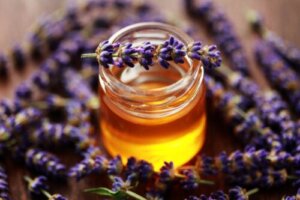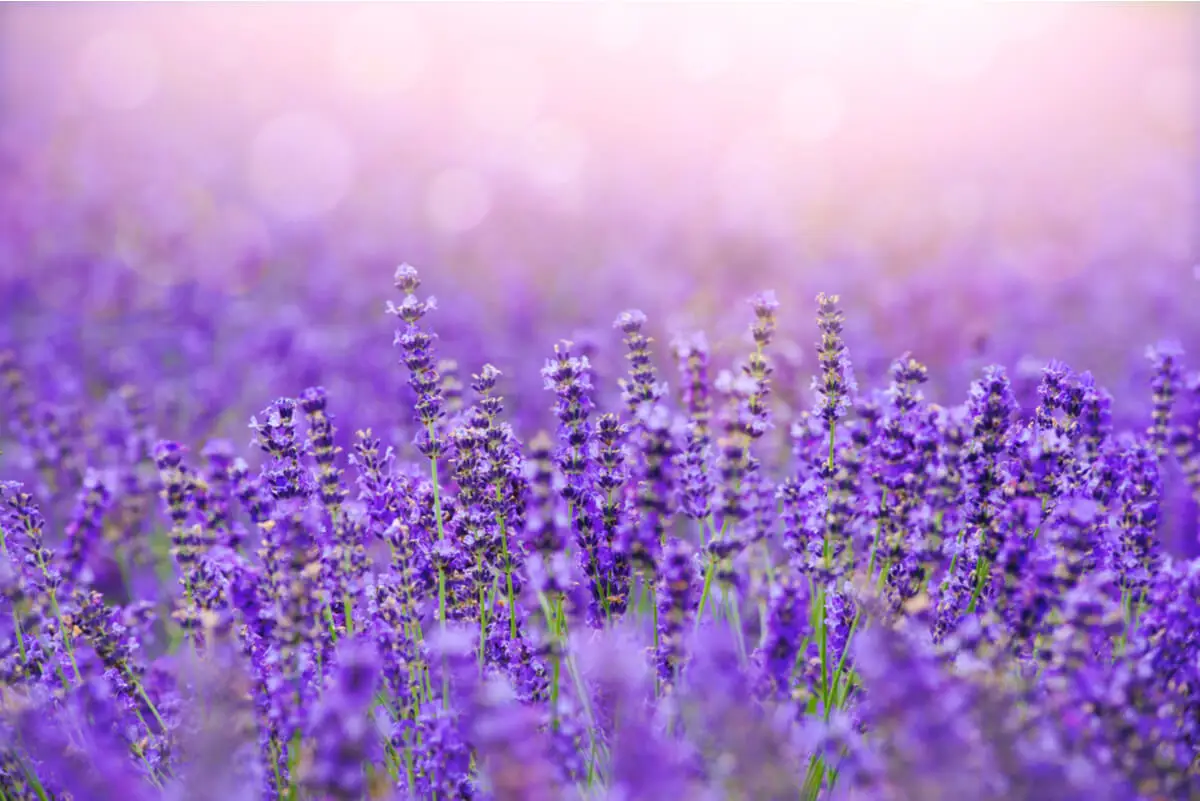Lavender Honey: Benefits and Uses


Reviewed and approved by the pharmacist Franciele Rohor de Souza
Lavender honey, also called “lavender honey”, is a product from the nectar bees obtain from the flowers of wild lavender(Lavandula stoechas) and other species of this plant. You can find it in various fresh markets.
According to a study shared in the journal Molecules, this type of monofloral honey contains volatile compounds that are associated with health benefits. In particular, its contribution of fatty acids, antioxidants and carbohydrates help to strengthen defenses and soothe various ailments. Let’s see in detail.
Characteristics of lavender honey
Of all the varieties of honey, lavender stands out for its particular aroma and mild flavor. As bees make it from the nectar of lavender species such as Lavandula angustifolia, Lavandula latifolia, and Lavandula stoechas, it has special characteristics of flavor, texture, and properties.
To be more precise, it has a light amber or white color, a medium crystallization and a fluid consistency. Its flavor is sweet, but has slight acidic and floral notes.
It is generally not subjected to heat processes, which allows it to retain its properties. It may even contain pollen and propolis particles.
Benefits and uses of lavender honey
Traditional medicine values lavender honey for its medicinal properties. Coming from the nectar of lavender, it is believed to provide “extra” nutrients and bioactive compounds compared to traditional honey.
In relation to this, a review shared in Integrative Medicine Insights highlighted that this type of honey shows more anti-inflammatory capacity than those coming from arbutus or citrus fruits. In addition, it had a positive effect on decreasing oxidative markers. What other benefits does it provide?

Strengthens the immune system
One of the main benefits of lavender honey has to do with its ability to strengthen the immune system. A study shared through Plos One details that this product concentrates enzymes, amino acids, flavonoids and phenols .
Together, these compounds help improve the body’s responses to infectious agents, such as viruses, bacteria and fungi. In fact, research shared in the Journal of Food Science and Technology found that this variety of honey helps fight fungal infections such as candidiasis.
Other studies have also investigated honey’s immunomodulatory capacity. Thus, it has been determined that it has the potential to fight inflammation, oxidative stress and infections caused by bacteria.
Contributes to cough relief
Both bee honey and Lavandula stoecha have properties that contribute to cough relief. Both act as anti-inflammatory, which reduces throat irritation. In addition, they have expectorant and moisturizing qualities, key to minimize this symptom.
In a systematic review shared in BMJ Evidence-Based Medicine, honey was found to be effective in improving the symptoms of upper respiratory tract infections (common cause of cough). Likewise, through the Cochrane Database of Systematic Reviews it was reported that honey relieves cough with superior effects to placebo and medications such as salbutamol.
It shortens the duration of this symptom in children.
Meanwhile, a publication in the journal Plants talks about the potential of Lavandula stoechas to contribute to the relief of cough. Specifically, it is attributed an expectorant effect that helps clear the airways.
We need more studies.
Helps skin care
Lavender honey also has cosmetic applications. Its topical use is related to diminishing scars, wrinkles and blemishes. This is linked to its abundant concentration of antioxidants, organic acids, minerals and amino acids.
In a comparative study in Phytotherapy Research, lavender honey was more beneficial in wound healing than the plant’s essential oil. This is also supported by research in the Journal of Functional Biomaterials, which discusses the potential of honey to stimulate skin regeneration.
Other possible benefits of lavender honey
Like any other variety of honey, lavender honey has other health benefits due to its abundant content of bioactive compounds. The most prominent are the following:
- Decreased stress and anxiety: one of the amino acids in this ingredient, tyrosine, acts as a precursor of several neurotransmitters associated with well-being, such as dopamine. Thus, it favors the relief of states of tension and anxiety.
- Reduction of insomnia: it is believed that lavender honey acts on the nervous system and favors the reduction of sleep problems. In itself, it is a natural relaxant.
- Diuretic effect: popular literature states that this honey stimulates the elimination of liquids and the relief of swelling associated with their retention. However, there are no clinical studies to prove it.
- Relief of diarrhea: due to its antibacterial and astringent properties, lavender honey helps to stop diarrhea in case of bacterial gastroenteritis.
Risks and contraindications of lavender honey
For most healthy adults and children over one year of age, lavender honey is safe as a natural sweetener, cough remedy and topical product (on superficial wounds). However, consider the following:
- In people allergic to pollen or other components of honey, this product may cause respiratory difficulties, dizziness, vomiting, heart rhythm alteration, among others. It is necessary to suspend its use and consult a doctor in this situation.
- Don’t feed it to children under one year of age due to the risk of infant botulism.
- Consume in moderation, since in excess it can lead to overweight and obesity, due to its high sugar content.
- People with diabetes should avoid its consumption.
- Experts don’t recommend its topical application on open wounds or severe burns, since in these conditions it favors infections.

Recommendations for the purchase and conservation of lavender honey
When purchasing lavender honey in the market it is necessary to check the label. Details such as the producer’s data, geographical and botanical identification and information of the packer can help to determine its quality.
When storing it, keep it in a cool and dark place, with a temperature between 15 and 20 °C. It is not advisable to put it in the refrigerator, since in very cold environments it tends to crystallize, making it difficult to consume later.
Is it possible to make homemade lavender honey?
There are some recipes for making “homemade lavender honey” on the Internet. However, these preparations are very different from real bee lavender honey. In fact, it is a form of infused honey.
Although it can acquire a smell and slight taste of lavender, its properties are different. In fact, you can make it with other herbs, spices, peels, fruits and flowers. Would you like to prepare it?
You need the following ingredients
- 500 grams of bee honey.
- 100 grams of dried lavender.
- A wooden spoon.
- A previously sterilized jar.
Instructions
- Put the honey in a heat-resistant container and heat it in a bain-marie.
- When it is hot, add the dried lavender and remove from the heat.
- Now cover the product and let it stand for 24 hours.
- After this time, heat it again in a bain-marie, over low heat, for about 5 minutes.
- After this, filter the product with a strainer to separate the remains of lavender.
- Store in a sterilized jar at room temperature.
What to remember about lavender honey?
Lavender honey is an organic product from the nectar that bees extract from different species of lavender. It’s not the same as infused honey; it does not have the same properties.
Due to its nutritional composition, experts recommend it as an adjuvant for defenses, wound healing, cough relief, anxiety control, among others. In any case, its consumption should be moderate, without leaving aside its contraindications.
All cited sources were thoroughly reviewed by our team to ensure their quality, reliability, currency, and validity. The bibliography of this article was considered reliable and of academic or scientific accuracy.
- Machado AM, Antunes M, Miguel MG, Vilas-Boas M, Figueiredo AC. Volatile Profile of Portuguese Monofloral Honeys: Significance in Botanical Origin Determination. Molecules. 2021 Aug 17;26(16):4970. doi: 10.3390/molecules26164970. PMID: 34443558; PMCID: PMC8400914.
- Denner SS. Lavandula angustifolia Miller: English lavender. Holist Nurs Pract. 2009 Jan-Feb;23(1):57-64. doi: 10.1097/01.HNP.0000343210.56710.fc. PMID: 19104276.
- National Center for Biotechnology Information (2022). PubChem Taxonomy Summary for Taxonomy 39331, Lavandula latifolia. Retrieved September 29, 2022 from https://pubchem.ncbi.nlm.nih.gov/taxonomy/Lavandula latifolia.
- Ez zoubi, Y., Bousta, D. & Farah, A. A Phytopharmacological review of a Mediterranean plant: Lavandula stoechas L. Clin Phytosci 6, 9 (2020). https://doi.org/10.1186/s40816-019-0142-y
- Miguel MG, Antunes MD, Faleiro ML. Honey as a Complementary Medicine. Integr Med Insights. 2017 Apr 24;12:1178633717702869. doi: 10.1177/1178633717702869. PMID: 28469409; PMCID: PMC5406168.
- Estevinho LM, Chambó ED, Pereira AP, Carvalho CA, Toledo Vde A. Characterization of Lavandula spp. Honey Using Multivariate Techniques. PLoS One. 2016 Sep 2;11(9):e0162206. doi: 10.1371/journal.pone.0162206. PMID: 27588420; PMCID: PMC5010229.
- Ajibola A. Novel Insights into the Health Importance of Natural Honey. Malays J Med Sci. 2015 Sep;22(5):7-22. PMID: 28239264; PMCID: PMC5295738.
- Estevinho, M.L., Afonso, S.E. & Feás, X. Antifungal effect of lavender honey against Candida albicans, Candida krusei and Cryptococcus neoformans . J Food Sci Technol 48, 640–643 (2011). https://doi.org/10.1007/s13197-011-0243-1
- Abuelgasim, H., Albury, C., & Lee, J. (2020). Effectiveness of honey for symptomatic relief in upper respiratory tract infections: a systematic review and meta-analysis. In BMJ Evidence-Based Medicine (Vol. 26, Issue 2, pp. 57–64). BMJ. https://doi.org/10.1136/bmjebm-2020-111336
- Mushtaq A, Anwar R, Gohar UF, Ahmad M, Marc Vlaic RA, Mureşan CC, Irimie M, Bobescu E. Biomolecular Evaluation of Lavandula stoechas L. for Nootropic Activity. Plants (Basel). 2021 Jun 21;10(6):1259. doi: 10.3390/plants10061259. PMID: 34205806; PMCID: PMC8234844.
- Mărgăoan R, Topal E, Balkanska R, Yücel B, Oravecz T, Cornea-Cipcigan M, Vodnar DC. Monofloral Honeys as a Potential Source of Natural Antioxidants, Minerals and Medicine. Antioxidants (Basel). 2021 Jun 25;10(7):1023. doi: 10.3390/antiox10071023. PMID: 34202118; PMCID: PMC8300703.
-
Lusby PE, Coombes AL, Wilkinson JM. A comparison of wound healing following treatment with Lavandula x allardii honey or essential oil. Phytother Res. 2006 Sep;20(9):755-7. doi: 10.1002/ptr.1949. PMID: 16807876.
-
Martinotti S, Ranzato E. Honey, Wound Repair and Regenerative Medicine. J Funct Biomater. 2018 May 8;9(2):34. doi: 10.3390/jfb9020034. PMID: 29738478; PMCID: PMC6023338.
- Jongkees BJ, Hommel B, Kühn S, Colzato LS. Effect of tyrosine supplementation on clinical and healthy populations under stress or cognitive demands–A review. J Psychiatr Res. 2015 Nov;70:50-7. doi: 10.1016/j.jpsychires.2015.08.014. Epub 2015 Aug 25. PMID: 26424423.
- Koulivand PH, Khaleghi Ghadiri M, Gorji A. Lavender and the nervous system. Evid Based Complement Alternat Med. 2013;2013:681304. doi: 10.1155/2013/681304. Epub 2013 Mar 14. PMID: 23573142; PMCID: PMC3612440.
- Honey: its antibacterial action in the treatment of gastroenteritis. Glimpse. 1985 Nov-Dec;7(6):1, 8. PMID: 12314387.
This text is provided for informational purposes only and does not replace consultation with a professional. If in doubt, consult your specialist.








